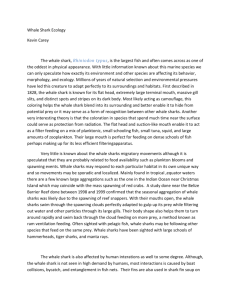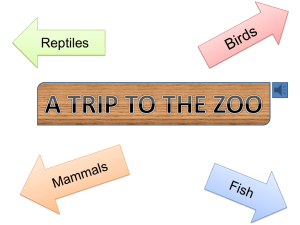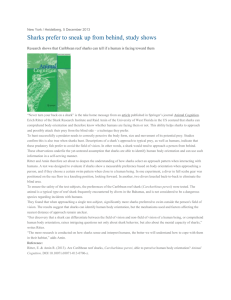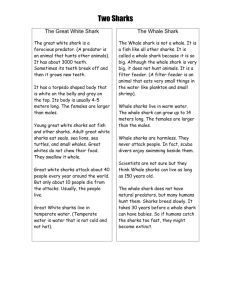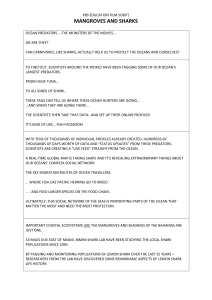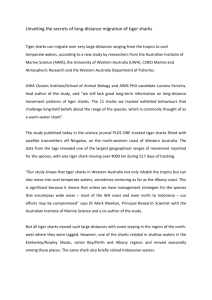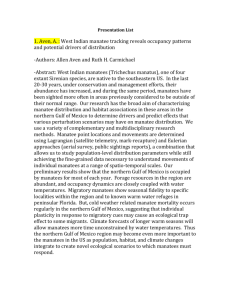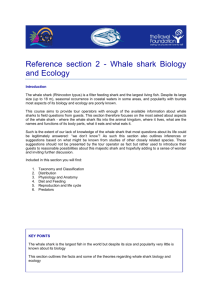Additional information (DOCX - 25.21 KB)
advertisement
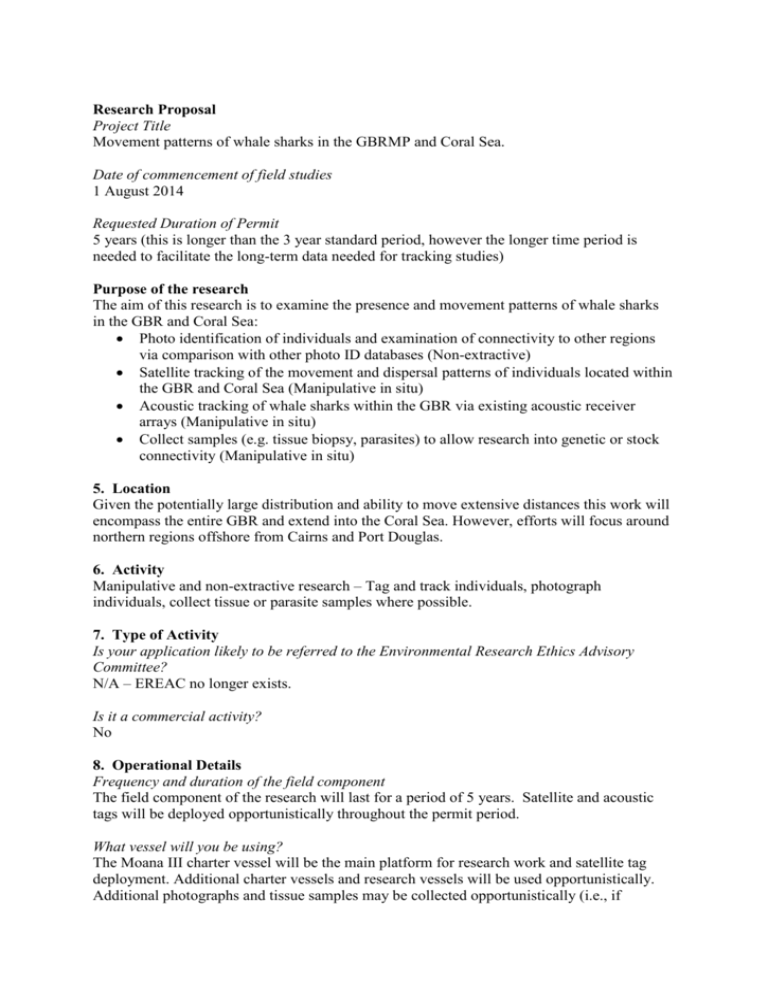
Research Proposal Project Title Movement patterns of whale sharks in the GBRMP and Coral Sea. Date of commencement of field studies 1 August 2014 Requested Duration of Permit 5 years (this is longer than the 3 year standard period, however the longer time period is needed to facilitate the long-term data needed for tracking studies) Purpose of the research The aim of this research is to examine the presence and movement patterns of whale sharks in the GBR and Coral Sea: Photo identification of individuals and examination of connectivity to other regions via comparison with other photo ID databases (Non-extractive) Satellite tracking of the movement and dispersal patterns of individuals located within the GBR and Coral Sea (Manipulative in situ) Acoustic tracking of whale sharks within the GBR via existing acoustic receiver arrays (Manipulative in situ) Collect samples (e.g. tissue biopsy, parasites) to allow research into genetic or stock connectivity (Manipulative in situ) 5. Location Given the potentially large distribution and ability to move extensive distances this work will encompass the entire GBR and extend into the Coral Sea. However, efforts will focus around northern regions offshore from Cairns and Port Douglas. 6. Activity Manipulative and non-extractive research – Tag and track individuals, photograph individuals, collect tissue or parasite samples where possible. 7. Type of Activity Is your application likely to be referred to the Environmental Research Ethics Advisory Committee? N/A – EREAC no longer exists. Is it a commercial activity? No 8. Operational Details Frequency and duration of the field component The field component of the research will last for a period of 5 years. Satellite and acoustic tags will be deployed opportunistically throughout the permit period. What vessel will you be using? The Moana III charter vessel will be the main platform for research work and satellite tag deployment. Additional charter vessels and research vessels will be used opportunistically. Additional photographs and tissue samples may be collected opportunistically (i.e., if encountered during other research efforts) while working from various JCU and AIMS research vessels. 10. Sampling details Background Understanding the movement and site fidelity of sharks and fish is fundamental to the development of sound management. This study will tag whale sharks in the northern GBR and Coral Sea to understand their movement patterns and define connectivity to other regions. This research will integrate with ongoing studies of shark and fish populations along the east coast of Queensland aimed at providing scientific data for improved management of shark populations. Procedure Non-extractive research Individuals will be encountered while freely swimming and will not be captured or restrained in any way during research procedures. The size of individuals will be estimated, sex noted and photographs taken for identification of individuals. Manipulative research Where possible a small tissue sample (biopsy) will be collected using a hand spear, and/or copepod parasites collected for genetic and stock assessment studies. Copepod collection will occur by hand collecting parasites from the mouth region of free swimming individuals. Up to 20 individuals per year (100 total over 5 year period if possible) will be sampled (for biopsy and copepod analysis) and fitted with pop-off satellite and/or acoustic transmitters. Both types of transmitter will be inserted into the dorsal musculature near the first dorsal fin or into the dorsal fin using a spear gun or hand spear. All vessel motors will be disengaged during tagging and tissue extraction. Only experienced individuals will be allowed to undertake sampling. New individuals will only be permitted to conduct sampling after full training by experienced staff and within accepted best practise for shark sampling and tagging. Tagging and biopsy sampling will be conducted based on previously approved methods in GBRMPA permit G14/36624.1. Dart tags (tethered to satellite and acoustic tags), in this case, will be applied via modified spear. This is the accepted approach for large sharks and world’s best practice for white, whale and basking sharks. The dart will be inserted into the dorsal musculature at the base of the dorsal fin. The spear contains a stopper to ensure the tag is seated at an appropriate tissue depth. These activities will fall under currently approved animal ethics permits from James Cook University (Approval No. A1933). Whale sharks tend to aggregate around fish feeding activity. As such in order to increase replication, fish attractants (burley) and fishing practices will be necessary as part of the research program. Given the pelagic and migratory nature of these species the attracting, tagging and sampling may need to occur in Marine National Park Zones. No fish collected as part of the attractant process will be retained, all will be released alive back to their original habitat – as that is not the focus of the study. Once whale sharks are seen the attractant process will cease. Due to the large expanse of Marine National Park Zones and Buffer zones offshore, notably offshore Cooktown and Cairns (B-14-3005; MNP 15-1034; MNP 16-1049; MNP 16-1056; MNP 16-1061) and these areas also being known for whale shark sightings, it is requested that access be granted to these zones (and all other offshore MNPZ and BZ) for the following reasons: 1) Cannot be reasonably conducted elsewhere: Whale sharks are large migratory animals. While all efforts will be made to undertake research in zones other than MNPZ and BZ, due to the large tracts of MNPZ and BZ offshore, this research needs to occur in these zones to be effective. Whale sharks can be extremely rare and sightings of these sharks have been seen in the MNPZ’s offshore Cairns and Cooktown. As part of the research, we would like to determine through tracking where these sharks go and how much of the GBRMP they actually use. Hence the request for access to MNPZ’s and BZ throughout the Marine Park. 2) The research is a priority for management: The Outlook Report 2009 lists our knowledge of sharks and rays as poor. Given the listed risks and impact the projected condition of sharks and rays (as per the Draft Strategic Assessment) is rated as Very Poor. Overall sharks and rays are considered to be in poor condition. While this may apply more to inshore species there is a large knowledge gap around whale sharks on the Great Barrier Reef. Given their tendency to migrate outside the Marine Park into less protected waters, understanding how important the Great Barrier Reef is to their survival is imperative. 11. Management considerations What are the likely impacts and benefits of this study on other users and the conservation values of the Marine Park? This project has many beneficial implications within this region. Results of this research will help define the size, structure and location of the whale shark population present along the east coast of Australia. Satellite and acoustic tracking will define how much of the GBR individuals use and how long individuals remain within Australian waters. Connectivity to other regions will be defined via satellite tracking of broad scale movements. Results of this study will provide benefits to users of the Marine Park by providing a better understanding of the movement of individuals within this system. These data will be crucial to management decisions by GBRMPA and the Department of the Environment. How have you reduced the impacts of this research? The study design is meant to have minimal or no impact in all respects. Sharks will remain free swimming during all procedures to minimise stress or other impacts derived from interaction with them.



